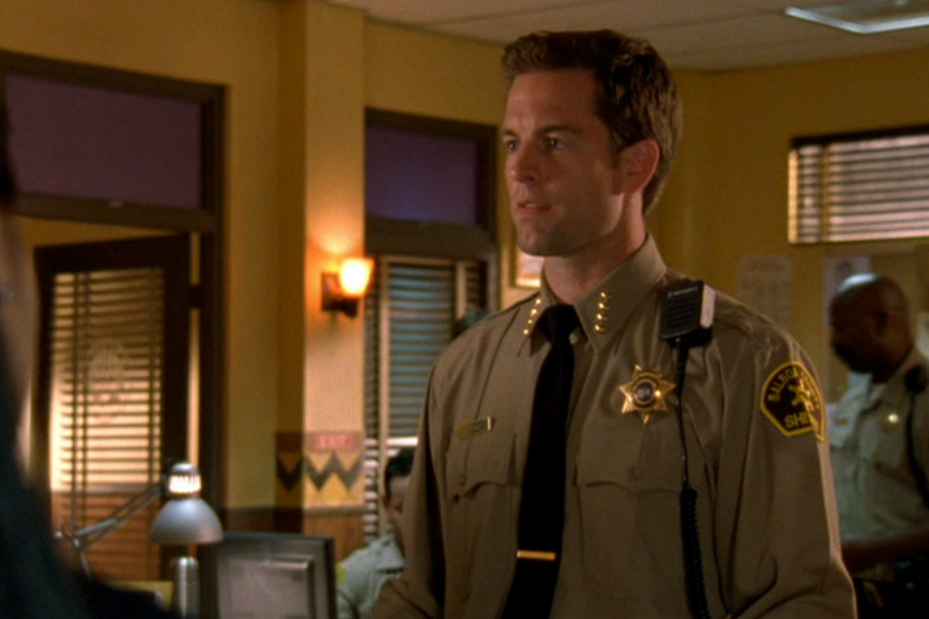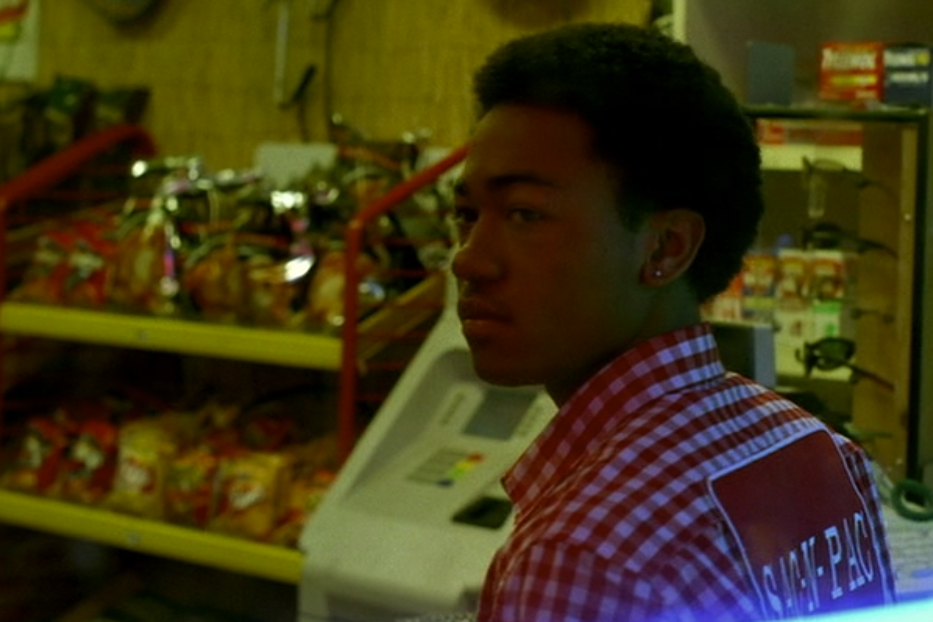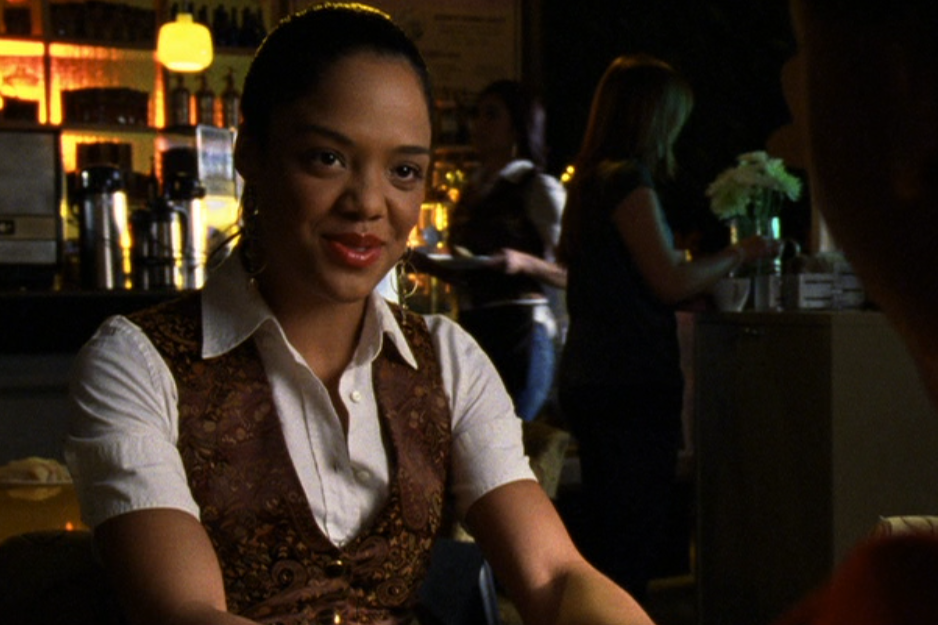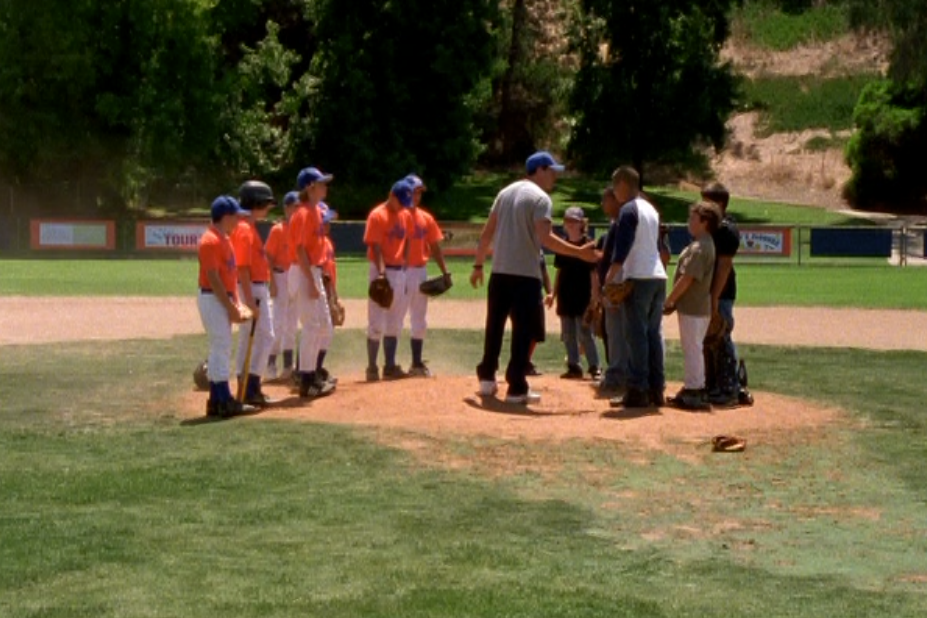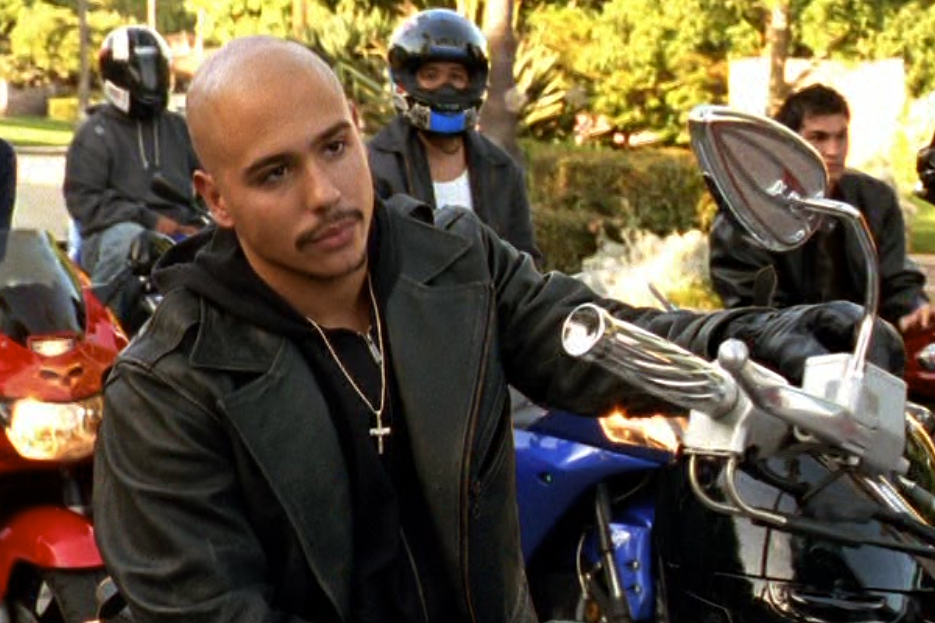“Same Scum, Different Wardrobe”
Uniforms and Costume Design on Veronica Mars
Originally published on Letterdrop 10/28/2021
What do you think of when you think of a uniform? Maybe a work uniform, a team uniform. Both are important on Veronica Mars, but when I rewatched the series, I realized that even more important are the social uniforms—the clothes that affiliate a character with their social group. And in that way, all the uniforms on Veronica Mars are social uniforms. Neptune is a city of vast economic and racial divides: if you’re wearing a waitress uniform, you’re probably not the child of a movie star or tech tycoon; if you’re wearing a cheerleader uniform, you’re probably not ostracized from the 09ers; if you’re wearing a puka-shell necklace, you’re probably not a PCHer. No matter who you work for, who you play for, who your friends are, your clothes are your uniform, and your uniform is your clothes; they signal where you belong and where you don’t.
Sheriff Lamb in his uniform (2.2)
Neptune is the seat of Balboa County and home to the Balboa County Sheriff’s Department, its sheriffs and deputies united in khaki and olive green. (U.S. sheriff departments often favor earthy browns and greens for their uniforms, which distinguish them from the blues of municipal police departments.)
Deputy Sacks in his uniform (and a sheriff jacket on the coatrack) (2.17)
While both the sheriff and deputies don a khaki collared shirt and olive pants and jacket, their decorations easily distinguish their ranks: Sheriff Don Lamb wears a black necktie with a gold tie clip and four gold stars on his collar. His deputies, including Jerry Sacks and Leo D’Amato, never wear ties or gold stars, their collars unbuttoned to reveal white undershirts. Their uniforms are both aligned with and inferior to Lamb’s; those who survive in the department either resign themselves to or embrace the sheriff’s corruption. (When a deputy tries to act from some moral center, they usually end up fired or killed—like Leo and Sacks, respectively.) After all, the sheriff’s department is the enforcer of Neptune’s racial and economic divisions, interested in protecting the city’s wealthy, white 09ers and harassing and jailing its communities of color.
Keith, in a navy button-down and brown slacks, leaves the sheriff's department (1.2).
Keith, in a khaki jacket and olive polo, embraces Veronica (1.2).
Veronica’s father, Keith Mars, used to be sheriff, used to wear the same black tie and gold stars as Lamb—except with, you know, less bribery. (Though Keith’s choices at the end of season three—once he’s donned the uniform again—prove that the office of sheriff is just as corruptible by a Mars.) Keith doesn’t wear the sheriff’s uniform in seasons one and two, and yet it still influences his wardrobe. As a private investigator, Keith often wears khakis, browns, and olive greens. I think specifically of a sequence in episode 1.2: we flashback to Keith leaving the department after his removal, wearing a navy-blue button-down and brown slacks instead of his uniform. In the present day, he picks up Veronica after her ex-boyfriend Duncan Kane’s car is almost impounded—a “misunderstanding” that is quickly cleared up by his powerful father, Jake Kane. Keith, of course, is wearing a khaki jacket and olive green polo; in many ways, he is still the real sheriff in town, still trying to solve the mystery of Lilly Kane’s murder, a mystery that Sheriff Lamb was happy to swiftly and cleanly resolve for the wealthy Kanes.
Veronica, too, is no stranger to uniforms: by season two, her father has convinced her to get a “normal” teen job: waitressing at Java the Hut. In Neptune, only the middle- and working-class kids have part-time jobs; the 09ers don’t need to work, and so these service uniforms separate the have-nots from the haves.
Wallace at Sac-n-Pac in his uniform (1.1)
Think of Veronica’s friend Wallace Fennel and his uniform at the (embarrassingly named) Sac-n-Pac: a red-and-white gingham shirt with a matching name tag and the store’s name on the back. There’s no way a Duncan Kane or a Logan Echolls would be caught working at a convenience store, but Wallace needs to; the dorky uniform is what the money’s for! (Sorry, I’m also rewatching Mad Men.)
Veronica in her waitress uniform, a white button-down and brown vest (2.19)
Veronica’s Java the Hut uniform is less humiliating, though not her style: a brocade vest, usually in brown, gold, or navy, with a white or black button-down and jeans. She works at Java throughout season two; in episode nineteen, a new waitress puts on the same uniform: Jackie Cook.
Jackie wears a cream sweater and matching beaded hoops and bangles to class (2.17).
Jackie is the daughter of legendary baseball player Terrence Cook, come to live with her dad for senior year. Jackie projects a world of privilege and wealth: a mother who’s a model, a childhood on the Upper West Side, an acceptance to the Sorbonne. She’s probably the most fashion conscious and glamorous of the recurring characters, not aggressively preppy or beachy like the 09ers. Rather, Jackie shops at designers like Miu Miu, favors cropped jackets or sweaters, sequined or beaded tops, belted jeans or capris. For jewelry, she often chooses hoop earrings (an intentional nod by the costume designers, I think, to the long history of hoops and Black female power and style).
Jackie in her waitress uniform: a white button-down and brown vest (2.19)
Jackie dates Wallace on and off, which rankles Veronica (partly, I think, because Jackie actually calls out the bullshit in the Wallace-Veronica friendship). Still, Jackie’s carefully constructed world starts to fall apart in episode thirteen, after Terrence is accused of orchestrating the bus crash that killed five students and one teacher. Suddenly, Jackie is Veronica at the beginning of season one, ostracized and humiliated by her former friends for her father’s alleged wrongdoing.
Jackie in her diner uniform (2.22)
It’s appropriate, then, that when Jackie needs a part-time job, she asks Veronica for help (2.19). Jackie’s surprisingly good at waitressing for a supposed newbie, and in episode twenty-two, we find out why: She’s not the daughter of a model, and she didn’t grow up on the Upper West Side. She and her mother are waitresses at a Brooklyn diner; Jackie has a two-year-old son. Her senior year with her father was a chance to get away from her old life; her glamorous past an invention. Her diner uniform is so far from her Neptune wardrobe, from even her Java the Hut uniform: a light blue dress and apron with navy trim and a name tag, old-fashioned and unfashionable, quite literally blue collar. Still, Jackie wears a pair of gold hoops, a chic cream trench and printed scarf, with her diner uniform; a sparkly silver shrug and white camisole when she says goodbye to Wallace: she’s still the same Jackie in Brooklyn as she was in Neptune, just without the artifice of privilege and money.
Wallace and his teammates in their Neptune basketball uniforms (1.16)
Really, the only official uniforms we see on 09ers are sports teams’: green and gold for Neptune. Duncan wears a soccer uniform; Meg Manning and other 09er girls wear cheerleading uniforms. Wallace is no 09er, but he gains social currency through his basketball skills and uniform. Even Veronica, back in her popular days, donned the T-shirt and green shorts of the pep squad. Sports uniforms are a sign of pride in, and allegiance to, Neptune High and Neptune itself—not feelings that present-day Veronica or any of her alt classmates hold for their school and city. In fact, the one time Veronica wears a cheerleading uniform is when her clothes are flushed during gym class and she must borrow Meg’s (1.8).
Woody tries to reconcile two teams, one uniformed, one not, in 2.2.
A brief study in team uniforms comes in episode 2.2: Local baseball team owner Woody Goodman coaches a Little League team; his players practice in immaculate orange-and-white uniforms. The poorer kids are without an official team or coach or uniform; they practice in a collection of old T-shirts and jeans. And yet, as we later learn, Woody’s squeaky-clean image as a coach, symbolized by his team’s pristine uniforms, is only a means to conceal horrifying secrets.
But of course, the biggest rivals in Neptune, more so than any sports teams, are the PCHers and male 09ers. Though the former is more officially a gang—the PCHers are a Latino biker gang named for the Pacific Coast Highway—the latter certainly acts like one, enforcing their supposed superiority as the whitest and wealthiest kids in Neptune. According to Veronica’s classmate Molly Fitzpatrick, she doesn't care whether a PCHer or an 09er killed her boyfriend because the two groups are the “same scum, different wardrobe” (2.17).
In the second episode of the series, the show quickly establishes the similarities and differences between the PCHers and 09ers through their costumes. For both groups, their clique is their job, their uniform, their identity. The PCHers survive through the protection and income of the gang; the 09ers don’t need to work for money, so being dilettantes is their work. Each has their leader: Weevil Navarro and Logan Echolls.
Weevil (foreground) with the PCHers (1.2)
The PCHers favor black leather jackets and gloves, black hoodies, and jeans, sometimes mixed with gray flannels and Henleys, bandannas or Timbs. Weevil often wears a silver cross—always around his Catholic grandmother—and small silver hoops or diamond studs. Still, the PCH wardrobe is largely about function: leather guards against road rash, black camouflages on the highway at night. Even Veronica throws on a bit of the PCH uniform, in the form of a black leather duster, when she visits the junkyard with Weevil in episode 1.5.
Logan (foreground) with the 09ers (1.2)
While the PCHers’ turf is the highway, the 09ers’ is the beach. The male 09ers love to surf, so their palette is beachy blues and browns—water and sand—their prints plaids and Hawaiian florals. They wear puka-shell necklaces, not crosses, because let’s face it, the only god they’re beholden to is the sea.
When the PCHers and 09ers face off at the end of episode 1.2, we can easily tell them apart by their clothes; and yet, both groups want the same thing: to punish a PCHer, Chardo. (He slept with Logan’s 09er girlfriend and framed Weevil for credit card fraud.) Different wardrobes, yes, but the same social contracts.
[The next post, on dreams and fantasies, will go out on Thursday, 11/11. If you enjoyed this post, please like, comment, or share.]
